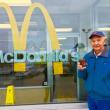Ketchup in his veins
Ever wondered how McDonald’s got its start?
A man from Boothbay, Robert Devine, can tell you. He worked for the company — considered one of the most successful in the world — for 10 years, starting before the word McDonald’s summoned up images of Big Macs, fries and milkshakes in households all over the globe.
Devine not only worked for the organization — he was hanging out with the founder of McDonald’s Corporation — Ray A. Kroc.
Devine has written two published books. In his newest one, a memoir called “Ketchup in My Veins,” he describes his years as a McDonald’s corporate employee, and the ups and downs of working for a major player in fast food America.
McDonald’s history goes back to 1938, when two young brothers, Dick and Maurice McDonald from Nashua, New Hampshire moved to California to seek their fortune in the movie industry.
“They learned, while they were there, about the new fashion of fast food,” Devine said. “You could pick up a sandwich and take it with you.”
The brothers opened a barbecue business in the Los Angeles area, closing it when World War II started and they couldn't find help. In 1944, they opened what would be the first real McDonald’s, serving hamburgers, cheeseburgers, french fries, soft drinks and milkshakes. The hamburgers were 15 cents.
During the ’50s, the brothers branched out, opening restaurants in Phoenix and a suburb of Los Angeles.
One day a salesman for Multi Mixer milkshake machines, Ray A. Kroc, started getting curious about the McDonald’s restaurants. The brothers had ordered several of the mixers. He drove to California from his headquarters in Chicago and introduced himself, hoping to sell more of his machines. But after spending a few days observing the business firsthand, he began negotiations to buy rights to McDonald’s.
In 1955, Kroc succeeded in negotiating the franchise for all McDonald’s restaurants east of the Mississippi.
On April 15, 1955, Kroc opened his first restaurant in Des Plains, Illinois. Two years later, after much “teeth-grinding and misunderstandings” with the McDonald brothers, Kroc succeeded in negotiating a contract for the worldwide rights to McDonald’s, Devine said. The price? $2 million.
He soon realized the true key to making McDonald’s a success was through franchising. “He was a classic salesman,” Devine said. “A man who could sell a refrigerator to an Eskimo.”
Kroc began franchising McDonald’s in 1957. At that time, franchises for the restaurants were only sold to people who owned property to them build on. “They would be their own landlord, and there wouldn't be a leasing issue between the franchisee and the landlord, McDonald’s Corporation.”
One day an entrepreneur named Harry Sonneborn approached Kroc with a proposition. Sonneborn was something of a financial wizard, according to Devine, and was adept at running businesses. “He told Kroc he wanted to work for him. Kroc demurred, but Sonneborn persisted. “He told Ray he would make him more money than he had ever dreamed of.”
Negotiations ensued, and Sonneborn became the first president of McDonald’s, but resigned within a year.
Kroc later told Devine that Sonneborn, more than anyone else, was responsible for the financial success of McDonald’s during its early years. “He conceived and developed the concept of making McDonald’s Corp. a real estate investment company, thereby becoming the landlord (owner) of the property and buildings. McDonald’s real money-making machine was, and is today, in its real estate holdings.”
Devine went to work for McDonald’s for the first time in 1966, after resigning from a 10-year stint as an aviation mechanic and a supervisor with American Airlines. He was living in Southern California with his wife and their five children. He quickly rose to the position of a store manager, and was soon promoted to administrative assistant and regional licensing manager, covering the western United States.
By then, McDonald’s was expanding at a rapid rate, and Kroc was a millionaire “many, many times over.” Devine said when Kroc divorced his wife he moved from Chicago to Los Angeles, and the two became friends. “He'd come into the office unannounced and plunk himself down in a chair in my office. It was a little daunting at first,” Devine said.
Devine was again promoted, this time to district manager for the corporation for all of northern California, parts of Nevada and southern Oregon.
In 1971, there were around 40 McDonald’s in and around the San Fransisco area, but none in San Fransisco proper, due to building permit laws. Devine was assigned the job of persuading the city board of appeals to award McDonald’s a building permit in San Francisco. He succeeded, and the first McDonald’s in San Fransisco was built.
McDonald’s went on to open “stores,”as Devine calls them, in countries worldwide, and he eventually left corporate headquarters and opened four of his own franchised stores in Houston.
Devine retired from McDonald’s 22 years ago, and a lot of changes have occurred in that time. “McDonald’s doesn’t stand still. It rolls along, so there are a lot of aspects about it that I’ve lost touch with,” he said. “But one of my sons owns and operates five McDonald’s in Texas. “He keeps abreast of what’s happening.”
Devine speaks highly of McDonald’s food. With a young family, McDonald’s was an affordable place to eat, and the Devines were frequent customers. “The food was good, and the restaurants were always clean. The french fries are great - made with russet potatoes, some from Idaho, and some from Maine.”
Devine moved to Boothbay with his wife, Pat, in 1994. When not writing, he is a watercolor painter, a still life photographer, a woodworker and a gardener.
For more about Bob Devine and McDonald’s, or for a signed copy of his book that sells for $14.95 plus tax, call 207-633-2767, or email rcdevine@hotmail.com.
Event Date
Address
United States
































